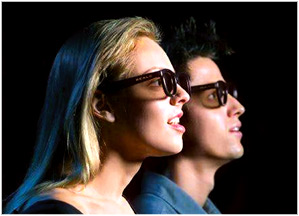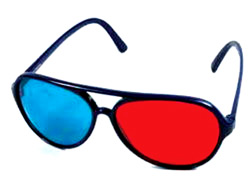Through the looking glass
Lahiru Sanjeeva
FERNANDO
 |
|
3D movies have
the effect of reaching out to you from the screen
 |
|
Watching movies using glasses |
|
Multitouch screens. iPads. 3D movies. Everywhere you look there is
demand for more experience in engaging in the content. This demand has
resulted in delivering a similar experience to its consumers.
Have you watched a 3D movie? One minute you find yourself flying next
to birds and catching a birdís eye view of the land below and the next
instance you are either diving in the deep sea, amid underwater marine
life, or gliding among the stars in space. Renowned movies like Avatar,
How To Train Your Dragon, Journey To The Centre of the Earth, Beowuf,
Toy Story 3 and Ice Age 3 have never ceased to mesmerise its viewers
with its three dimensional effects. The experience seems to be so much
of a reality that we almost believe that we are sucked into the screen
and living among the characters of the tale.
It is hard to imagine how a simple screen and a set of glasses helps
you to share such a wondrous experience but that is only the outer layer
of this fabulous discovery. Many are curious about how the magic unfolds
before us. The answer is both reassuringly simple and inordinately
complex, depending on who you ask and how you look at it. Here is a
glimpse at the secret behind this successful formula.
3D movies began their development stages from 1915 but could not
reach quality standards until 2009. William Friese-Greene experimented
with this technique from the 1980s. According to his discoveries the
movie needs to be projected to the screen in two sides and the audience
should view the film through the stereoscope. Though you are able to
view 3D images, this method was not practical enough to be introduced to
film theatres. Some effective technological discoveries connected with
3D cinema emerged in recent times.
Eye impression of the three dimensional
This is a small trick that you can perform to understand the
technology better. Hold your pen still in front of your face. Close your
right eye and look at the pen. Now close your left eye and look at the
pen. Switch the perspective and scrutinized the view which you saw with
each of your eyes. You will see the same object in the same position but
it is slightly off set. You will soon realize that each eye sees
different parts of something that we are able to see.
The two images of the same object enter the brain. The brain
possesses a high genetic power to make up the disparity of these two
images. It can easily identify all the angles and figure out the
disparity between the two images. It has the capacity to sync the images
through matching and measuring the object. Unfortunately camera cannot
perform the same actions without destroying the image even if it is
captured in two different perspectives.
How 3D movies are created
The 3D movies are created by two angles viewing the same scene from
two separate cameras positioned left and right. These are set in this
manner to simulate the distance between audienceís eyes.
Then the result is projected through a special system to the silver
screen. The audience need to wear special filter glasses (Rotational
Polarized Glasses) to experience the impact.
 The brain fuses these images together giving a view of a strong
illusion of depth in and out of the screen. The Rotational Polarized
glasses which are worn by the audience allow the image to be separated
as a left and right view. The brain fuses these images together giving a view of a strong
illusion of depth in and out of the screen. The Rotational Polarized
glasses which are worn by the audience allow the image to be separated
as a left and right view.
3D glasses
Anaglyph glasses were used earlier to witness the 3D effects of a
movie. One glass is red and the other glass is blue in these particular
glasses. The movie too needs to be projected in those tones for the
viewers to witness the results.
This method was not effective for full range of colour products and
led to many problems such as unclear and mixed up images. Later
Polarized Glasses made their entrance to theatres and proved to be much
more sufficient than anaglyph glasses.
According to this method a film can be projected in two different
angles. One in a horizontal manner and the other in a vertical manner.
The relevant glass allows the eye to be horizontally polarized while
being vertically polarized in the other eye.
A drawback of this system is that you need to keep your head still to
see the 3D effect. If you shake your head the waves become distorted
while reaching to your eyes. It messes the colour and does not give a
clear 3D image.
The most effective way to view a 3D film these days is by using
Rotational Polarized Glasses.
These equipments have the capability of polarizing the two different
images rotationally in clock wise for one eye and counter clockwise for
the other eye. Now you can tilt your head as you wish and see the 3D
images without any problem.
The Future of 3D
The revolution of the 3D technology has emerged. It has developed the
mechanism to project two different images of the same scene captured by
cameras with the relevant disparity to the left and right eye to make it
3D efficient.
This is only the beginning. The day that we will be able to watch a
3D movie without wearing glasses if not far away. |





